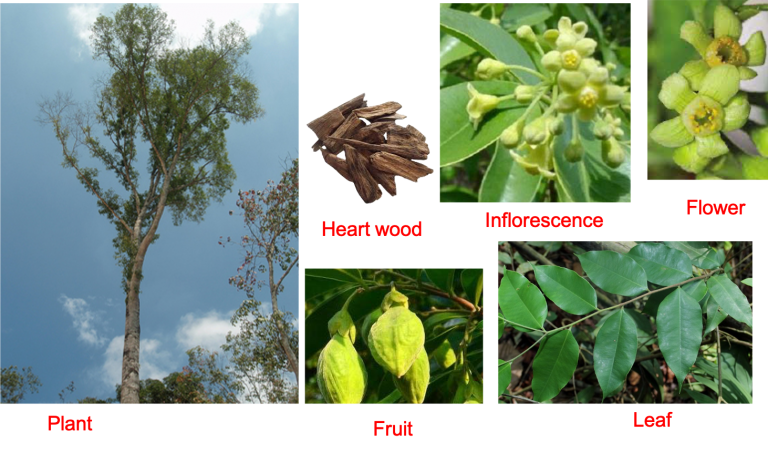AGARU
The plant Agaru is one of the most important plant in the list of medicinal plants that are present in the books of Ayurveda. The plant is a very valuable economically especially for its volatile oil which is extracted from the heartwood of the mature tree. There are many references which show the use of this place since ancient period. Formulations like Agarvadi Taila are present in classical texts like Charaka Samhita which are supportive for its prolong use. Not only in Ayurveda, it is also a part of formulations present in Unani system too. Being a plant that has उष्ण (Ushna) veerya this is useful in containing the cold feeling especially in the conditions where chills are prominent. The botanical name of the plant is Aquilaria agallocha Roxb. The name Aquilaria is the latin name for eagle while agallocha is a greek word for which means ‘making exceedingly glorious’. This denotes the aspect of its colour and nature of the wood which is a usable part of the plant.
PLANT DETAILS
BOTANICAL NAME
Aquilaria agallocha Roxb
FAMILY
Thymelaeceae
NOMENCLATURE
VERNACULAR NAMES
- Kannada – Krishnaagaru
- Malayalam – Kayagharu
- Tamil – Kalimankam
- Telugu – Agaru chettu
- Hindi – Agar
- English – Agarwood or Eagle wood or Aloe wood
SANSKRIT SYNONYMS
- लोह (Loha) – Heavy as iron
- अग्नि (Agni), अग्निकाष्ट (Agnikashta) – Has Ushna veerya or Hot potency
- क्रिमिज (Krimija), क्रिमिजग्द (Krimijagda) – Infested with Krimi (Fungi)
- वनद्रुम (Vanadruma) – Commonly grows in wild.
- प्रवर (Pravara) – The best in class.
- राजार्ह (Rajarha) – Suitable for royalty
- शृ्ंगज (Shringaja) – Grows on hills.
- विश्वधूप (Vishwadhupa) – Useful as perfume and make incense sticks
- च्यवनद्रुम (Chyavanadhruma) – Evergreen tree
SAMHITA CLASSIFICATION
- Charaka Samhita – शीतप्रशमन (Sheetaprashamana), श्वासहर (Shwasahara), शिरोविरेचक (Shirovirechaka) & तिक्तस्कनदध (Tiktaskanda).
- Sushruta Samhita – एलादि (Eladi), सालसरादि (Salasaradi) & श्लेष्मसंशमन (Sleshmasamshamana)
NIGHANTU CLASSIFICATION
- Dhanvantari Nighantu – Chandanadi Varga
- Bhavaprakasha Nighantu – Karpuradi Varga
- Raja Nighantu – Prabhadradi Varga
- Kaiyadeva Nighantu – Aushadhi Varga
BRIEF MORPHOLOGY
A large evergreen tree that grows upto 80 feet height with thin bark. Leaves are thin leathery acute 5-10 cms in length and 2-3cm breadth. The inflorescence is umbels with small greenish yellow coloured flowers seen in young branches. Fruits are capsule, obovoid in shape compressed and yellow in colour. The seeds are ovoid with a long tail and brownish black in colour. The main usable part is the heartwood which is dark and resinous. It is odourless in the beginning and obtains odour only after being infected with a fungus known as ascomycetes. The tree then releases a dark resin in response to the infection which gives the dark colour. The resin gets accumulated and embedded in the wood which gives its characteristic dark colour.
PHARMACOGNOSY OF OFFICIAL PART
MACROSCOPY
YET TO BE COMPILED
MICROSCOPY
YET TO BE COMPILED
PART USED AND POSOLOGY
PART USED
काष्ट / काण्ड (Heart wood)
DOSE
चूर्ण (Powder) – 1 to 3 gms तैल (Oil) – 1 to 3 drops
PHYTOCHEMISTRY
The agar wood is rich in essential oils, volatile oils, resins, saponins, flavanoids, phenols, steroids,triterpenoids, tanins and sequiterpenes like agarol, kusunol, aquillochin, agarotetrol, etc. The oil contains agarol, dyhydrokaranone, tetradecanoic acid, etc. Among these constituents it is Agarol which produces the odour.
रसपञ्चक कर्म PROPERTIES AND USES AS PER AYURVEDA
गुण (Properties)
- रस (Rasa) – कटु (Katu), तिक्त (Tikta)
- गुण (Guna) – लघु (Laghu), रूक्ष (Ruksha), तीक्ष्ण (Tikshna)
- वीर्य (Veerya) – उष्ण (Ushna)
- विपाक (Vipaka) – कटु (Katu)
- प्रभाव – स्नेह
कर्म & प्रयोग (Action & Indications)
- दोषकर्म (Doshakarma) – कफवातशामक (Kaphavatashamaka) & पित्तल (Pittala)
- धातुकर्म & मलकर्म (Dhatukarma and Malakarma) – Main actions – त्वच्य, व्रणरोपण, शीतप्रशमन, श्वासहर, क्रिमिघ्न (Twachya, Vranashodhana, Sheetaprashamana, Shwasahara, Krimighna)
- Other Actions – वेदनस्थापन, रसायन, कासहर, सुगन्धी, कर्ण्य, नेत्र्य (Vedanasthapana, Rasayana, Kasahara, Sugandhi, Karnya, Netrya)
- प्रयोग (Prayoga) – Mainly व्रण, कुष्ठ, श्वास, दद्रु, कार्णरोग, नेत्ररोग (Vrana, Kushta, Shwasa, Dadru, Karnaroga, Netraroga), also useful in ज्वर, वेदनयुक्त वातविकार, मुखदुर्गन्घ, सन्धिवात, आमवात, etc (Jwara, Vedanayukta vatavikara, Mukhadurgandha, Sandhivata, Amavata, etc)
AYURVEDIC FORMULATIONS
CLASSICAL
- अगर्वादि तैल
- इरिमेदादि तैल
- खदिरादि वटि
- अणु तैल
- दशाङ्ग धूप
- अपराजित धूप
PROPRIETARY
- NONE OBSERVED
AGRONOMY
ENVIRONMENT
The plant is supposed to grow well in the hilly areas especially at a height of around 2500 to 3000 feet above sea level. It is well suited in the Northeastern India with a temperature ranging from 20 to 33 deg C. It also needs a relatively high humidity of 75 to 85% with yellow, red or clay and sandy soil.
CULTIVATION
Seeds are used to propagate the plant. But, seeds have very less viability. Hence it should be placed in the soil or nursery environment before it is exposed to environment with adequate planning and management. In conducive conditions the plants grow quickly with achieving optimum size at around 4-6 yrs.
HARVESTING
The harvest is done for the infected wood by the fungus. Hence if not natural there are methods for artificial inoculation of the same when it gets mature enough. The inoculation produce the scented resin in the wood in around 3-4 months after the process. Naturally it takes 10 years to give the yield. The average yield is around 4kg oil from one tree.
STORAGE
The oil is extracted from the infected wood through distillation (Hydro or steam) and is usually stored in dark glass sealed containers which are away from light as it contains volatile oils.
VARIETIES AND SUBSTITUTES OR ADULTERANTS
VARIETIES
As per Raja Nighantu, it is of four varieties namely
- कृष्ण (Krishna)
- काष्ट (Kashta)
- दाह (Daha)
- माङ्गल्य (Mangalya)
ADULTERANTS
NO KNOWN ADULTERANTS
SUBSTITUTES
The other species of the genus aquilaria like Aquilaria malaccensis Lam. is being used as a substitute instead of this plant.
TOXICITY
TOXIC SYMPTOMS
- As such there is no proved toxicity of the plant nor its essential oil. But there is a fair chance of hypersensitivity as this known to be vitiating Pitta Dosha.
ANTIDOTE
- Not Applicable as such. But can be using the treatments that control Pitta Dosha can be used.
शोधन or PURIFICATION METHOD
- NOT NECESSARY
THERAPEUTIC USES
EXTERNAL USES –
The oil is a stimulant and fragrant. Hence its application over the body will lead to fragrance. It is also known for its anti-inflammatory and analgesic action. The application of the oil is useful to treat ulcers, wounds, ringworm especially painful and inflammatory conditions. As per the reference from Charaka Samhita, the oil named Agarvadi Taila with the plant as the main ingredients is useful in controlling the chills that are due to high temperature.
INTERNAL USES –
The oil is given internally in the form of nasya to treat breathlessness or other kapha dosha related disorders. It will also be useful as mouth freshener, carminative too. As per the text of Dravyaguna by V M Gogte, the drops are to be smeared over the betal leaves and chewed to treat the condition of Asthama.
CONTROVERSY (IF PRESENT)
YET TO BE COMPILED
LIST OF RESEARCH STUDIES
- Janey Alam, Mohd. Mujahid, Badruddeen, Md. Azizur Rahman, Juber Akhtar, Mohmmad Khalid, Yasmeen Jahan, Abdul Basit, Akhlaque Khan, Mohd Shawwal, Shoiab Shadab Iqbal. An insight of pharmacognostic study and phytopharmacology of Aquilaria agallocha. J App Pharm Sci, 2015; 5 (08): 173-181.
- Wang S, Yu Z, Wang C, Wu C, Guo P, Wei J. Chemical Constituents and Pharmacological Activity of Agarwood and Aquilaria Plants. Molecules. 2018;23(2):342. Published 2018 Feb 7. doi:10.3390/molecules23020342.
- Chhipa H, Kaushik N. Fungal and Bacterial Diversity Isolated from Aquilaria malaccensis Tree and Soil, Induces Agarospirol Formation within 3 Months after Artificial Infection. Front Microbiol. 2017;8:1286. Published 2017 Jul 11. doi:10.3389/fmicb.2017.01286.
The video on AGARU emphasises on the various aspects of the plant especially with respect to its cultivation and its characteristics for identification such that they are preserved for the future generations.



